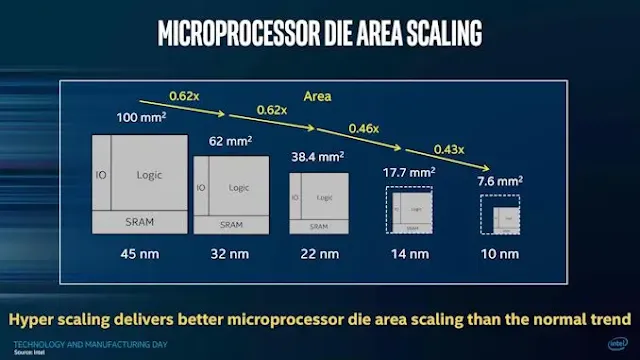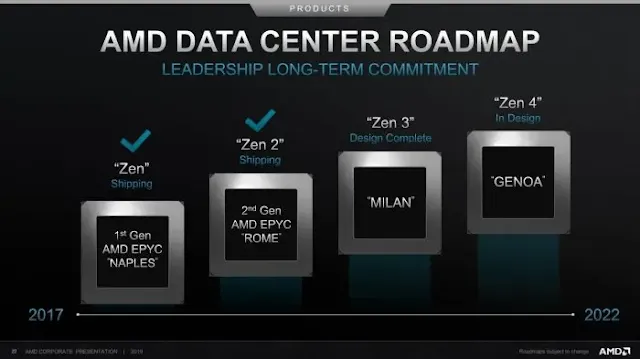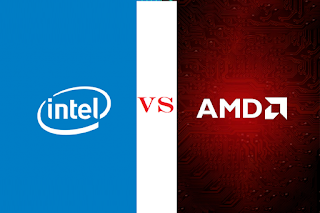Microprocessors and Intel and AMD in history
The Intel 4004 is the world's first single-processor microprocessor with a single processing unit, launched by Intel in November 1971. The company was established in 1968. Robert Noyce and Gordon Moore were two engineers at the Fairchild Semiconductor Company. Many left the Fairchild Company that year to start their own company. Intel was established for the sake of this agitation. Those who came out of Fairchild were called Fair-Children then.
 |
| Intel 4004; Image Source: Supinfo |
Jerry Sanders was not left out of this agitation. Ten months after the founding of Intel with seven colleagues, he also left Fairchild to establish Advanced Micro Devices (AMD). Now let’s mention some important things here.
As a company, AMD and Intel are two different styles. AMD is a much smaller company than Intel. AMD's don’t make their own chips themselves, they just design. Manufactured by third party companies such as TSMC. But Intel has more than a dozen of its own manufacturing plants, most of which are located in the United States, China, Israel, and Ireland.
Many may think, I heard the name of AMD a few days ago. Where have they been for so long, where did they come from now? In fact, in the processor race, AMD has never been as competitive as Intel. With the ever new technology, Intel popularized their processors in such a way that AMD was a few generations behind Intel. In 1978, Intel released their 8080 processor. This processor of x86 architecture (refers to the processor architecture, the design, and instruction set of the processor, i.e. how the processor will work) lays the foundation for desktop computing. The chip market of this platform has maintained its existence for almost 30 years.
 |
| From left Gordon Moore, Robert Noyce, and Jerry Sanders; Image Source: wccftech |
Intel later incorporated the x86 or 32-bit platform chip into their Pentium series, which gained a lot of popularity. Since then they have expanded their thinking. Let's take a look at some important Intel processor timelines.
- 1971: Introduction of the world's first microprocessor. Intel 4004.
- 1974: Intel 8080. The first desktop computer chip.
- 1978: Intel 8086. The first 16-bit processor.
- 1982: New series Intel 286 unveiled. But Bill Gates called it a brain dead chip. Because it could not run more than one DOS application.
- 1989: The first processor with more than 1 million transistors.
- 1993: Launch of the popular Pentium series. The number of transistors in this 32-bit processor was more than 3 million. Since then, each processor has been included in a series.
- 1995: Introduces the first processor for servers and workstations, called the Pentium Pro. It was the first supercomputer to cross a teraflop.
- 1998: Intel Celeron series unveiled. Intel has launched this series to compete with AMD in the low budget market.
- 2000: Intel Pentium 4. All single-chip processors are included in this series through this processor, which can be used from desktops to laptops.
- 2001: Xeon brand unveiled. It is designed separately for servers, workstations.
- 2006: Intel core solo and Duo are released. It is Intel's first two-core mobile, a processor for laptops or notebooks. It was first used on MacBooks.
- 2007: Intel introduces the TickTock processor model. A tick means that the processor of the new manufacturing technology will be made that year, and Tick means a new microarchitecture.
- 2008: Intel Core i7 series launched. It is targeted for business and gaming. This is called the success of the Core Duo. At present, its core number can be 4 to 10.
- 2009: Intel Core i5 series launched. The innovation of turbo boost technology which can give the required performance. This series can be called a middle-class series.
- 2010: Intel Core i3 series, known as the entry-level series. It is made for entry-level desktops and laptops.
- 2017: Intel has been following the tick-tock rule since 2010. Every year they release new processors with new features and improved performance. This year, Intel took out the Core i9 series to take the technology one step further. This series is primarily for computer enthusiasts who want to keep their systems up to date with the latest technology.
AMD's path
A lot has been said about Intel. Now let's talk about AMD. Although established in 1969, they have not started building processors since then. They initially made a register and counter national products, and made their debut as a public company in 1972. In 1975, AMD released its first microprocessor, the AM9080. They figured it out by reverse engineering Intel's processors. An agreement was later reached between Intel and AMD - AMD will be able to manufacture processors designed by Intel. It benefits them in business as well as technology. Many more days later, Intel licensed their x86 architecture to AMD, prompting AMD to start designing and manufacturing processors for IBM.
 |
| AMD's headquarters in Santa Clara, California; Image Source: Britannica |
Despite being licensed, Intel was far ahead of AMD in terms of their technological prowess. In 1996, AMD released their own designed K5 processor, which competed with Intel's first-generation Pentium. The following year, they released the k6 processor, which brought fame to their processor world. One of the features of this processor series was floating-point capability, which was an important feature to increase the power of the processor. To compete with Intel, AMD has always kept their processor prices lower than Intel's, so that AMD's K6-2 chip competed with Intel's Pentium 2 and 3 to capture more than 80 percent of the market in 1998. In 1999 AMD was their AthlonSeries, which could work faster than Intel's Pentium 3. In the years that followed, AMD remained silent, but in 2003 they made a huge breakthrough in the processor world.
64-bit architecture; They express it by the Athlon 64 processor. After losing to Intel, they became the first builders of 64-bit desktop processors. This time the old thing is happening again, only this time Intel got their 64-bit architecture license from AMD. Which was not a happy moment for Intel either. For this, Intel's i386 for 32 bits and amd64 for 64 bits have to be used by both the companies. But now the term AMD is used more to increase the range of 64-bit processors.
 |
| Some differences between Athlon 64 and 32 and 64 bits; Image Source: Windows club |
In 2005, AMD spread its fame in the world of processors with new technology. With the Athlon X2 processor, they create new possibilities for multicore, i.e. processors made with more than one chip, whose current popularity is skyrocketing. But then their business collapsed. Intel continues to move fast due to their intelligence and marketing, but AMD lags behind due to bad decisions. Like Intel, AMD had its own manufacturing lab. But because of their bad business, it is no longer possible for them to supervise, so they sell the labs. At present they do not have their own lab. AMD's goal was to return to the market with a processor with more cores, but Intel continued to advance in single-core and multi-core performance. AMD's PhenomX4 and FX The series gained some popularity in the middle.
 |
| Zen architecture; Image Source: Wccftech |
Following this, AMD unveiled their completely redesigned Zen architecture, which opened new doors for the company's future and brought down Intel.
The emergence of Raisen and AMD
In 2016, AMD released its Raizen series. In line with Intel's series, they released Raizen 3, Raizen 5, and Raizen 6. Their core numbers also matched those of Intel's i3, 5, and i7. Raizen is a completely redesigned processor from AMD, with single-core and multi-core performance far superior to previous FX series. Built on 14-nanometer technology, the processor became a competitor to Intel's top processor lineup, the i7, which Intel has dominated for decades.
 |
| Processor area in nanometers; Image Source: Anand Tech |
General users, gamers, and content creators - these three groups of people are targeted at the processor. Ordinary users do not have to worry about the processor. Because a processor can do all the common tasks like typing, Facebooking, youtube, etc. very well. But gamers need more performance in the core single thread, and creators need multicore performance. The single-core performance of Intel processors has always been good, and because of its long reign in the gaming industry, games were optimized for Intel processors. But in the new Zen series, AMD focuses on improving single-core performance, and they are already far ahead of Multicore, so the multicore performance of these new processors surpasses that of Intel's processors.
Another interesting aspect of AMD was the price of their products. To compete, they kept the price of their processors lower than that of Intel. Before the arrival of Raizen, Intel was exclusive to the top tier processor lineups. As a result, the price of the processors was much higher. Raisen quickly gained popularity for its availability and performance. But for Intel, AMD's Zen 2 architecture has become a nightmare. These processors made with 7-nanometer technology are very popular among creators and gamers. AMD unveiled the Raizen 9 in July 2019, with a core number of base models surpassing even Intel's I9 model.
 |
| Intel and AMD's top lineup in performance; Image Source: Tweak Town |
Intel used to make their XEON processors for workstations, but the price of these processors skyrocketed as a number of cores. AMD releases the EPYC series to give them an ace. The number of cores is more than 3 times more than Intel's Xeon and the price was 3 times less than Intel's.
 |
| Roadmap for AMD's server processors; Image Source: AMD |
AMD is the first to launch a new series between desktops and workstations. These are called HEDT (High-End Desktop) processors. Raisen Threadripper is the processor in their HEDT series. These 27, 32, and 64 core processors are for very high-level creators. Note that Intel does not have a processor to compete with Threadripper. At the pace at which AMD is advancing, their market share will soon increase compared to Intel's. According to a report, the Ryzen 5 3600 processor has sold more than Intel's entire lineup.
 |
| Processor sales volume, April 2018 to May 2019; Image Source: Mindfactory |
Even after all this, Intel is still king. Because AMD's latest high-end processor was released in 2012. And every year Intel launches a new processor market and occupies almost the entire CPU market. According to the pass mark, AMD's market share after Raizen is now 40 percent. The last time they had this market share was in 2006, which was 18 percent of AMD in 2016.
This is possible because of Raisen. A large part of Intel's market share comes from laptops. This year, the Raizen 4000 series will be seen on laptops, which AMD claims to outperform Intel's desktop processors. If that is the case, then there is a bigger push ahead for Intel.
 |
| Upcoming Raizen 4000 Series; Image Source: AMD |
It takes a lot of writing to highlight 50 years of history. That's all for now. But technological warfare is a good thing for consumers. It offers good prices. Under the pressure of AMD, Intel has also reduced the prices of their products. The advantage is the general public, whether he is a fan of Intel or AMD!

















